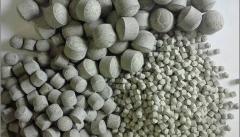
Laboratoire
Soutenance de thèse de Danai Panagiota TYRI
The safe operation of geological repositories for radioactive waste indicates the progressive galleries closure, by installing sealing and backfill materials. The French radioactive waste management agency (Andra) currently considers as backfill the implementation of crushed excavated Callovo-Oxfordian (COx) argillite, mixed with bentonite (MX80) in pelletized form, due to operational advantages. The pelletized mixture is emplaced inside the galleries at dry state, initially presenting granular structure and is gradually homogenised, due to swelling upon groundwater infiltration.Objective of this PhD thesis is the determination/fabrication of the pelletized mixture and its hydro- mechanical study. The granulometry is selected according to the highest possible packing density. Thus, it is defined as optimum grain size distribution (GSD). The implemented COx/MX80 mixture needs to produce adequate swelling capacity and low hydraulic conductivity.Numerical and experimental gravitational deposits are conducted to study the compactness of a granular material, without mechanical compaction. Numerical simulations using the Discrete Element Method investigate the granulometric effect on the resulting packing state, defining an optimum GSD. Supplementary experiments are used to finalise the granulometric selection maximising the resulting density. Both studies investigate the influence of additional parameters (e.g. implementation protocol, inter-particle friction, deposit height).The pelletization of the selected GSD is attempted for the first time on COx/MX80 powdered mixtures, by applying the compression method using a tablet machine. The process is analysed to successfully fabricate pellets and optimise the challenging pellet productivity.COx/MX80 mixtures hydro-mechanical behaviour is experimentally investigated by performing infiltration tests under free and confined volume conditions. A parametric study on various powdered mixtures is conducted to characterise the materials physicochemical properties and primarily evaluate their swelling capacity at densities expected upon implementation. On the other hand, the finalised pelletized assembly presenting various compositions is directly tested in terms of swelling pressure and hydraulic conductivity.

